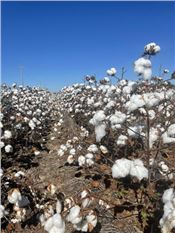Defoliation Thoughts As We Move Into October

DR. TYSON RAPER
JACKSON, TENNESSEE
This has been a big week for defoliation. Most of the calls have consisted of one or two questions. First, how long should I wait on acres that are nowhere near ready and second, what is the concoction when the weather is this cool? In this blog, I share a few thoughts on timing and some results from a strip trial we completed in cool conditions during 2020.
Boll maturity and timing
Bolls are continuing to mature at these temperatures, but the process of maturation has slowed down tremendously. The relationship between boll maturation and temperature is well established. The base temperature of 60F that we use to calculate heat units has been identified and verified through several efforts as the most appropriate season-long base, but thermal time approaches like degree days have several inherent weaknesses and cannot perfectly describe growth and development of an organism. As nighttime temperatures fall into the 40s, physiological functions of the plant drastically slow.
Normal function may resume if temperatures move back up into an acceptable range (60s at night) but the response is not immediate.
While progression from a soft-sided boll to a hard-sided boll might take a week in normal temperature ranges, expect the process to take much longer now.
Consider the value of the immature boll you are waiting on and the risk of weathering the open bolls below when timing that first shot.
If the plant is 70 percent open and the uppermost boll is easily dented with your thumb, I would have a hard time waiting for that position to mature. However, if the crop is 20 percent open, I might wait; the risk of a weather event damaging closed bolls is relatively low. Preconditioning is not a management approach that pays. Spraying ethephon alone will not hasten maturity, it only starts the process of opening an immature boll. Spraying a defoliant all but stops maturity. It is best to wait until you make the decision to defoliate and open, and then apply.
Remember that the general rule of thumb is to have something out by the end of the first week of October. Temperatures through next week do not look to be considerably better than this week. Although sunshine and time, even at these temperatures, will help mature bolls, I’d plan on making the first application within the next 10 days. If you decide to wait longer, watch the forecast carefully and make sure that you have the capacity to spray all remaining acres with a few days to spare before a freeze arrives. Frosts cause little boll damage but a freeze on a closed boll represents a loss.
Products
During the fall of 2020, I completed a strip trial in temperatures that averaged 5-8 degrees warmer than our current nighttime temperatures; night temperatures in the five days following application of that trial were were 54, 55, 55, 59 and 57. You can review the ratings from the above strip trial by clicking here and you can watch a flyover of the plots in the video above. The above visual and ratings capture several points that are reinforced every time we complete a cool weather defoliation trial. I’ve briefly summarized those below.
1. Save the thidiazuron-containing products for next year. Unless temperatures move back into the mid to upper 50s, this active will not provide any return on investment. Activity of straight thidiazuron products (Dropp/Daze/Freefall/TDZ etc.) will be greatest when night temperatures are in the mid to upper 60s. Activity of thidiazuron plus diuron products (Ginstar/Adios/Cutout) will be greatest when night temperatures are in the low to mid 60s. This week and next week, our night temps are in the mid to upper 40s with only a few nights over 50F. Some have indicated they will spike thidiazuron with diuron. I have encouraged and will continue to encourage those interested in doing that to spray a pass without thidiazuron at all (just diuron and boll opener) to see the value of thidiazuron provided at these temperatures. The activity you observe with an application of Ginstar/ Adios/Cutout at this temperature range will be provided by the active diuron, not the active thidiazuron; this is confirmed in the video and in the ratings by observing the remaining leaves on treatment 1 and comparing the Ginstar treatments with Folex treatments. Activity of thidiazuron requires temperatures that we do not have in the forecast.
2. Folex is our best option for a first shot in cool or cold temperatures. Many have communicated hesitation running 8-10 ounces of Folex because it sounds hot. Folex can stick leaves but it rarely sticks leaves at those rates in these temperatures. Recall, not long ago, defoliation consisted of a pint of Def and a pint of Prep!
3. Unless you have very few juvenile leaves, we are now in a two-shot scenario. Folex is very good at removing mature leaves but is not good on juvenile leaves. . . and we have plenty of juvenile leaves this year. As we increase the rate of Folex, we do see some additional activity on juvenile leaves but it will still likely not generate an acceptable level of juvenile leaf shed. With these temperatures, our second shot should consist of a PPO, adjuvant and boll opener. Our options now include Aim, ET, Sharpen, Display and Reviton. Rates and adjuvants vary by product. The two that I’ve received the most calls on are Aim and ET. Aim at 0.75 oz plus 0.25 percent NIS OR ET at 1.5 oz plus 0.5 percent COC will likely be my rate if temps hold in the 50s and max temps remain below 80.
As always, reach out if you have any questions and best of luck as we move into October. ∆
DR. TYSON RAPER: Cotton & Small Grains Specialist, Uniiversity of Tennessee